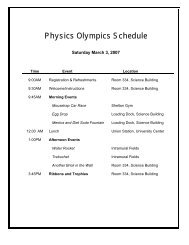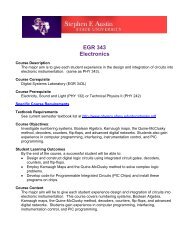Comprehensive Study Guide For Physics 101 Laboratory Exams
Comprehensive Study Guide For Physics 101 Laboratory Exams
Comprehensive Study Guide For Physics 101 Laboratory Exams
You also want an ePaper? Increase the reach of your titles
YUMPU automatically turns print PDFs into web optimized ePapers that Google loves.
Complementary Colors (Two colors that add to give white)BroadSlitCyanFilterConvexLensRay BoxScreenRedFilterBroadSlitMagentaFilterConvexLensRay BoxScreenGreenFilterBroadSlitYellowFilterConvexLensRay BoxScreenBlueFilter12
Addition of ColorsBroadSlitBlueFilterConvexLensRay BoxScreenMagentaRedFilterBroadSlitGreenFilterConvexLensRay BoxScreenYellowRedFilterBroadSlitGreenFilterConvexLensRay BoxScreenCyanBlueFilter13
Astronomical TelescopeFigure 1. Astronomical Telescope.Distant Object(An arrow)f oEyef o+ +f ef eObjective(Convex Lens)Eyepiece(Convex Lens)Galilean Telescope(Opera Glass)Figure 5. Galilean Telescope (Opera Glass).Distant Object(An arrow)30f o+f ef o+feObjective(Convex Lens)Eyepiece(Concave Lens)15
Stretch Versus Weight0.30sloperiserun0.05meters17.0Newtons 0.00294 meters / Newton0.26Stretch (meters)0.220.18rise = (0.21 - 0.16) meters= 0.05 meters0.14run = (34.0 - 17.0) Newtons = 17.0 Newtonsy-intercept = 0.11 meters0.100 10 20 30 40 50 60Weight (Newtons)Figure 1. Example Graph.17
The Simple PendulumPurpose:To use a simple pendulum to calculate the acceleration due to gravity.Recall from lecture that a pendulum will execute simple harmonic motion for smallamplitude vibrations. The period is the time that it takes for the pendulum bob to make oneoscillation, while the frequency is the number of oscillations the pendulum makes per second.Period (T) and frequency (f) are reciprocals of one another; that is,T = 1 for f = T1 .The period of a pendulum is independent of themass but depends on its length and its amplitude (angle ofswing). If the displacement angle is small (less than 10),then the period of the pendulum depends primarily on thelength (l ) and the acceleration due to gravity (g) orT = 2 g .Squaring both sides of the equation yieldsT24g2.This can be graphed with as the independent variable and T 2 as the dependentvariable. The y-intercept should be zero and the slope should be 4 2 /g. Therefore, theacceleration due to gravity can be determined from the slope. (<strong>For</strong> comparisons assume the localvalue of g is 9.81 m/s 2 or 981 cm/s 2 .) [Note: Pendulums are used in a variety of applicationsfrom timing devices like clocks and metronomes to oil prospecting devices.]19
Addition of VectorsPurpose:To learn about the addition of vectors.Recall that a vector is a physical quantity that has a magnitude and an associateddirection. In other words a vector has both a magnitude (length) and a direction (anglemeasured from a defined direction). One way of adding vectors is to represent them with arrowsthat have length and direction. Consider the three vectors below that are to be added.NF 1 3 N @ 45F 2 1 N @ 60WESNotice that the vectors are drawn on a set of axes that look like a compass - north is up,south is down, east is right, and west is left. The first force vector can be specified as having amagnitude of 3 Newtons and a direction of 45° north of east. The second force vector has amagnitude of 1 Newton and a direction of 60° north of east. The third has a magnitude of2 Newtons and a direction of 210° north of east (or 30° south of west). The resultant (vectorsum) of these three force vectors is written as R F F .1 2 F3Notice that the arrow above each letter is a reminder that the quantity has both magnitudeand direction. The resultant of these three vectors can be measured experimentally by using the"head-to-tail" method. (Refer to the figure on the next page.) Draw all the vectors sticking thetail (blunt end) of one vector to the head (pointed end) of another. Do this in several steps. First,add F 1 and F 2 . To do this, draw F 1 and then stick F 2 on the head of F 1 . Always keep eachvector in its proper orientation in space as shown in the figure. The resultant R ' of F 1 and F 2 isthe vector drawn from the tail of F 1 to the head of F 2 . The length of R ' and its orientation inspace represent the vector sum of F 1 and F 2 .To add F 3 to F1and F 2 , place F 3 at the head of F 2 and connect the tail of F 1 with thehead of F 3 . This is the resultant of F1+ F2 + F 3 and is indicated by R . The resultant ismeasured to be 2.2 Newtons. The direction of the resultant is measured with the protractor to be66° north of east.F 3 2 N @ 21020
F 3F F 22R 'R F F 11The resultant can be checked experimentally on anapparatus called a force table (shown to the right). On the forcetable four mass hangers are attached to cords passing overpulleys mounted on the edge of a horizontal circular metal table.The rim of this table has a scale marked off in degrees. The fourcords are hung from a small ring slipped loosely over a post atthe center of the table. To do vector addition on the force tablefor the three vectors mentioned in the above example, designatea mass hanger to be F 1 , a different mass hanger to be F 2 , and a third mass hanger to be F 3 .Move each cord to the angle for the vector it represents. Add the appropriate masses to eachhanger so that the weight of the hanger and its load equal the magnitude of the force that is beingrepresented. Below is shown the force table (top view) with the cords in the proper positions.The line labeled E is a quantity called the equilibrant. Its magnitude is 2.2 Newtons,and its direction is 180° from the resultant. In other words, the equilibrant is the value of thevector that just balances the three vectors. The resultant is the sum of the three vectors (shownas dotted). If the equilibrant balances the resultant, then the resultant force on the ring is zero.So when the three vectors to be added are placed properly with respect to the equilibrant and thesmall pin at the center of the table is removed, then none of the weights move.F 2R F 1F 3E <strong>For</strong>ce Table21
Yellow is the addition of the red and blue.Examples of the Addition of VectorsYellow is the addition of the red, blue, and cyan.22
Linear MomentumPurpose:To demonstrate and verify the vector nature and conservation of linearmomentum.The momentum of a particle is defined as the product of the mass of the particle times itsvelocity (a vector quantity which obeys the rules of vector addition). That isp mv where p is the momentum of the particle, m is the mass of the particle and v is its velocity. Aslong as there are no external forces acting on a system of particles, collisions between theparticles will exhibit conservation of linear momentum. This means that the vector sum of themomenta before collision is equal to the vector sum of the momenta of the particles aftercollision.This is easily demonstrated in a simple experiment where two objects collide in ahorizontal plane and then undergo projectile motion after the collision. Since the horizontalcomponent of velocity remains constant for a projectile in free fall, the horizontal part of theprojectile motion can be used to represent the horizontal component of the momentum aftercollision.Ball ABall BPlumb BobPaperFigure 1. Linear Momentum Apparatus.23
Centripetal <strong>For</strong>cePurpose:To learn about uniform circular motion and centripetal force.Below is a diagram of the centripetal force apparatus:RadiusPulleyStringBobSpringSlottedMassesIndexFigure 1. Centripetal <strong>For</strong>ce Apparatus.The spiral spring exerts the centripetal (center seeking) force on a bob that travels in ahorizontal circle. The force is found from knowing the mass (M) of the bob, its angularvelocity () and its radius of rotation (R). The force can be experimentally checked by directmeasurement of the tension in the spring.Important TermsRadian - is an angle unit based on an angle measurement that is the ratio of the arc length of acircle divided by the radius of the circle. A full circle has an arc length of 2r. Divide thatby r to get 2which would be 2 radians. That means 2 radians = 360 0 .Centripetal force - is a center-seeking force and is the kind of force necessary to make a objectdeviate from traveling a straight line.Angular velocity is 2 radians divided by the time for one revolution.24


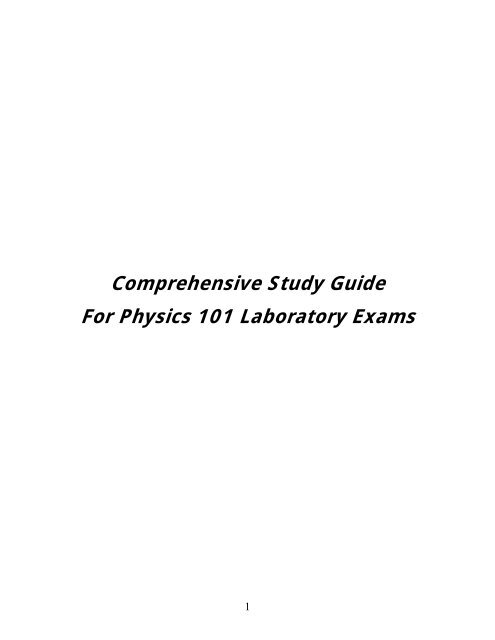



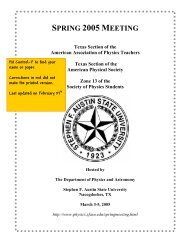

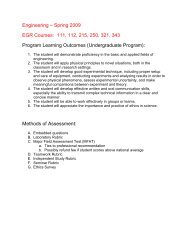
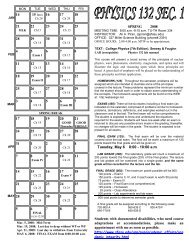
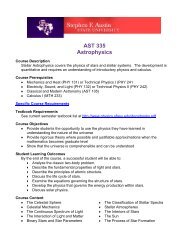

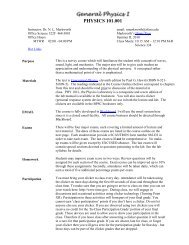
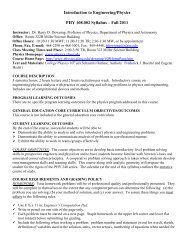
![[pdf] physics 110 fundamentals of electronics](https://img.yumpu.com/29312006/1/190x245/pdf-physics-110-fundamentals-of-electronics.jpg?quality=85)
